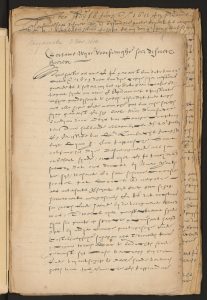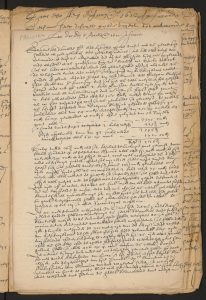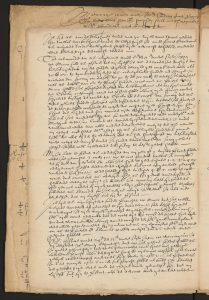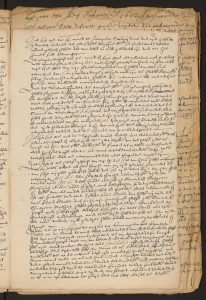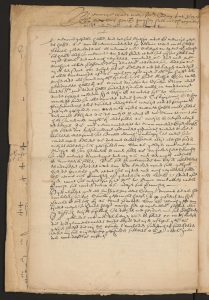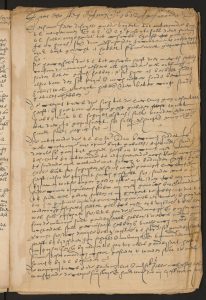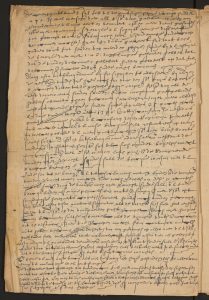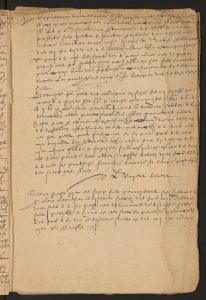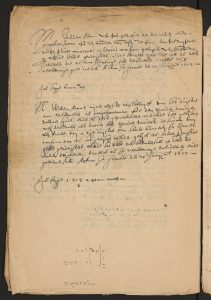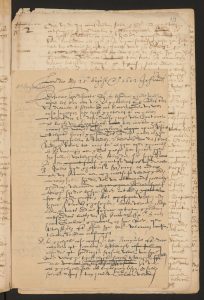English
Discovery of Historical Documents Related to William Adams
- Posting date:
- 2023/07/19
The International Research Center for Japanese Studies (Nichibunken), in collaboration with the National Archives of the Netherlands in The Hague (Nationaal Archief) and the Faculty of Humanities of Leiden University, has recently discovered four copies of letters from Jacques Specx, the first head of the Dutch factory in Hirado, to William Adams, an Englishman who acted as an advisor to Tokugawa Ieyasu.
We found the letters in a packet (inventory number 1.04.02:1054) in the National Archives’ collection of Dutch East India Company (VOC) documents. There are several packets listed under this inventory number and they contain copies of letters and documents produced by various trading offices of the Dutch East India Company between 1607 and 1612. The letters and documents were sent to the Dutch headquarters as a reference for the executives of the Dutch East India Company, the Heren Zeventien.
1) About the packet containing the copies of the letters to Adams (1.04.02:1054)
The Dutch East India Company, established in 1602, dispatched a fleet to Asia every year and established factories (trading posts) in various parts of Asia. In Japan, a Dutch factory was established in Hirado (now Hirado City, Nagasaki Prefecture) in 1609.
At the time of the establishment of the Dutch East India Company, there was no permanent head office in Asia. When the fleet dispatched to Asia returned to the Netherlands, they brought back internal documents collected from each factory as reference for the Heren Zeventien.
The packet with the copies of the letters to Adams is one of several packets containing documents produced at factories in Asia between 1607 and 1612, brought back by the Dutch East India Company’s fleet returning from Asia. The documents have been arranged in packets according to factory, namely Patani, Siam, Japan, and Johor. There are about 1,500 pages of documents in all. There is no standardized pagination, but some documents have their own pagination.
The documents originating from the Dutch factory in Japan are kept in one packet, and consist of 23 numbered folios (46 pages) in total. These folios comprise 10 copies of letters sent by Jacques Specx, the first head of the Dutch factory in Hirado, and 2 copies of letters sent by Hendrik Brouwer, the second head of the Dutch factory in Hirado.
Page 1 of Letter (1)
List of the letters in the packet with documents related to the Dutch factory in Hirado by date. At some point the letters were numbered in pencil by an archivist, who unfortunately made some mistakes in the ordering of the pages. The mistakes have been corrected in the page numbers given below.
(1) Jacques Specx at Nagasaki to the Heren Zeventien at Amsterdam, 3 November 1610 (ff. 1-5)
(2) Jacques Specx at Hirado to Lambert Jacopszoon Heijn at Siam, November 1610 (ff. 6-9)
(3) Jacques Specx at Hirado to Lambert Jacopszoon Heijn at Siam, 8 November 1610 (f. 9)
(4) Jacques Specx at Hirado to William Adams at Suruga, 5 April 1612 (ff. 12-13)
(5) Jacques Specx at Hirado to William Adams at Suruga, 8 June 1612 (ff. 10 and 15; the date of the letter is erroneously given as 8 June 1611)
(6) Jacques Specx at Hirado to Matthias at Osaka, 8 June 1612 (ff. 14 and 11)
(7) Jacques Specx at Hirado to William Adams at Suruga, 20 June 1612 (f. 16)
(8) Hendrik Brouwer on board the Rode Leeuw met Pijlen to Hendrik Janssen at Patani, 13 July 1612 (ff. 22-23)
(9) Jacques Specx at Hirado to William Adams at Suruga, 25 August 1612 (f. 17)
(10) Jacques Specx at Hirado to Hendrik Janssen at Patani, 2 November 1612 (ff. 18-19)
(11) Jacques Specx at Hirado to Cornelis van Neijenrode and Maarten Houtman at Ayutthaya, 3 November 1612 (ff. 20-21)
(12) Hendrik Brouwer in Japan to Hendrik Janssen at Patani, 4 November 1612 (f. 23)
2) Contents of the Adams-related documents
Of the above twelve letters, four, namely (4), (5), (7), and (9), are letters by Jacques Specx addressed to William Adams.
The contents of each of these four letters to Adams are as follows.
(4) Jacques Specx at Hirado to William Adams at Suruga, 5 April 1612 (ff. 12-13)
This letter is a response to three letters that Specx received from Adams. Although these three letters are not extant, Specx’s letter indicates when and from where Adams sent the letters. The place and date of each letter are as follows.
(A) Osaka, 28 November 1611
(B) Kyoto, 11 December 1611 (“8th of the 11th month in the Japanese calendar” in Specx’s letter)
(C) Suruga, 27 December 1611 (“24th of the 11th month in the Japanese calendar” in Specx’s letter)
One characteristic of Specx’s letter is that he summarizes the contents of Adams’s letter and then responds to it or expresses his opinion. Therefore, through Specx’s letter, we can understand the contents of the original letter from Adams.
First, in Adams’s letter (A) dated 28 November 1611, he reported in detail about the sales transactions he conducted in Osaka for the Dutch East India Company. He also conveyed information about the audience of the Spanish ambassador from Luzon with Ieyasu and about the health of Prince Maurits.
Adams’s letter (B) of 11 December 1611 contained a detailed report on his transactions for the Dutch East India Company in Sakai and Kyoto.
Finally, Adams’s letter (C) of 27 December 1611 gave a detailed report on the events after Adams’s arrival in Sunpu (Suruga). There Adams had an audience with Ieyasu and presented the gifts to Ieyasu on behalf of the Dutch East India Company. Adams also reported to Specx that the Spaniards denied the signing of the Twelve Years’ Truce (1609) between the Dutch Republic and Spain and reprimanded Adams as a liar in front of Ieyasu. He also denied in front of Ieyasu rumours that Specx had left Japan without permission, an act for which Specx shows sincere gratitude in his reply.
The content of Specx’s reply to Adams’s letters is mainly related to commodity trading, but we can see also a request to investigate how to obtain the high quality hai-fuki silver from Sado. The export of this commodity was prohibited. That is why Specx asked Adams to keep this matter secret.
(5) Jacques Specx at Hirado to William Adams at Suruga, 8 June 1612 (ff. 10 and 15)
This letter is dated 8 June 1611. However, examining the contents of the letter and comparing it with the contents of another letter that Specx sent to his assistant Matthias on 8 June 1612, we found that the year of the date should be 1612 and not 1611.
Specx’s letter is a response to a letter received from Adams dated 29 April 1612 (the date is given in the Japanese calender in the original, being the 29th of the 3rd month). A notable point in this letter is the description that Adams delivered steel and iron sand worth the enormous amount of 109,000 maes (a Japanese unit of measure of silver, monme) or about 218 million JPY in modern currency for the king (the term “king” was mostly used to denote Hidetada, the second Tokugawa Shogun). This indicates that Adams was an intermediary for large transactions between the Dutch East India Company and the Tokugawa Shogunate. The letter also reveals that Adams passed on information to the Dutch about Spanish trade practices, and the prohibition and the movements of Catholic priests. From this letter it also becomes clear that Adams took care of a sword presented to Specx by Ieyasu after Specx had an audience with Ieyasu in Sunpu in 1611.
Apart from responding to Adams’s letter, Specx asked Adams to pay 6,000 maes of silver on behalf of the Dutch East India Company to Matsura Takanobu, lord of the Hirado domain, on his arrival in Sunpu. The letter instructs that this amount should be deducted from the Dutch East India Company’s sales proceeds for goods deposited by Adams.
(7) Jacques Specx at Hirado to William Adams at Suruga, 20 June 1612 (f. 16)
This letter contains a detailed explanation of the request for payment of 6,000 maes of silver to Matsura Takanobu, lord of the Hirado domain, which was mentioned in the previous letter (5). Specx asks Adams to show as much friendship and respect as possible to the Lord of Hirado and his vassals.
On the reverse side of this letter, we can see a bill of exchange for 6,000 maes and another for 1,000 maes, 2,000 maes, 3,000 maes, and 4,000 maes addressed to Adams (see photo above right).
(9) Jacques Specx at Hirado to William Adams at Suruga, 25 August 1612 (f. 17)
This letter was written to inform Adams of the arrival of a Dutch ship in Hirado (the Rode Leeuw met Pijlen). After a description of the cargo of the ship, Specx mentioned the ship brought a letter addressed to Ieyasu and Hidetada from Prince Maurits and from the governor general of the Dutch East India Company (Pieter Both). He also informed Adams that the Dutch were going to have an audience with Ieyasu in Sunpu and asked for his cooperation on the occasion of the audience. He also stressed that if the Spanish and Portuguese envoys arrived in Sunpu before the Dutch, Adams should deny their claims that there was no truce between the Spanish and the Dutch.
Specx mentioned that letters from Adams’s wife (Mary Hyn) and his friends arrived with the ship, and that they would be given to Adams when they met in Sunpu. Specx also mentioned the return to Japan of Adriaen Cornelissen, one of the former crew members of the Liefde. He asked Adams to convey the good news of his arrival to his Japanese wife and daughter.
3) Background of the discovery
Since 2015, the International Research Center for Japanese Studies has been collaborating with the National Archives in The Hague and the Faculty of Humanities of Leiden University to conduct research on sources related to the Dutch factory in Hirado held by the National Archives. In order to promote joint research among the three institutions, the three institutions signed an Agreement for Academic Cooperation on 9 December 2016.
Based on this Agreement, the International Research Center for Japanese Studies and the Faculty of Humanities of Leiden University have received digital data of sources relating to the Dutch factory in Hirado from the National Archives and are collaborating on their transcription, Japanese translation, and research.
The fact that some letters were addressed to Adams was discovered during the process of translation. These letters do not specify the sender or addressee. The only information given is the place and date of writing. In addition, they were written as drafts, making them difficult to decipher. Furthermore, a mistake was made in the year in letter (5). Mistakes were also made by an archivist in the numbering of a couple of pages, which would lead to confusion about the contents if that numbering were followed. The transcriptions and the translations will be published in the correct order.
However, based on the location and date of the entries, the contents of the letters, and the contents of letter (6) dated 8 June 1612, addressed to Matthias, we could determine that these letters were addressed to Adams and that the sender was Specx. Specx had sent his assistant Matthias to Osaka in order to assist Adams in his efforts to sell the factory’s goods. His letter to Matthias relates in detail Specx’s correspondence with Adams. The fact that the contents of the letter to Matthias corresponded with the contents of the letters to Adams was a clue that led to the discovery of a connection between the four letters mentioned above and the fact that they were addressed to Adams.
As a result of the aforementioned joint research, the transcriptions of the letters will be published by Leiden University Press, and the National Archives will incorporate the transcriptions in their database. The International Research Center for Japanese Studies is planning to publish Japanese translations. The subject of the research is about 2,000 pages of incoming and outgoing letters, resolutions, and court journey diaries created between 1609 and 1633. Currently, about 1,500 pages have been transcribed and about 500 pages have been translated into Japanese.
We are planning to publish the first volume of the Japanese translation in the fiscal year 2021. This first volume will include Japanese translations of Specx’s Letter Book (1614-1616, inventory number 1.04.21:276). The second volume is planned to be published during the fiscal year 2022 and will include Japanese translations of the early Dutch factory’s incoming and outgoing letters, court journey diaries and resolutions from 1609 to 1616. This second volume will also include the Japanese translation of the newly discovered letters addressed to Adams.
4) Significance of the discovery
Many sources relating to Adams have survived. Eleven of Adams’s letters have been handed down. In addition, four journals of Adams’s voyages to the Ryukyu islands (2 journals), Cochin China and Tonkin (each 1 journal), his contract with the British East India Company and his will, as well as seven letters received by Adams are extant. Based on these sources, as well as other sources such as Specx’s diary of his court journey to Sunpu and Edo in 1611, and the diary of the chief of the English factory in Hirado, we can reconstruct Adams’s course of life quite accurately. However, until now, there were no sources available that provide clues to Adams’s activities between 1611 and 1612. With the present discovery, we can fill in the gaps for this period.
That we could identify the sender and recipient of four of the letters in the Japan section of the packets described above as respectively Specx and Adams, is of great significance for the utilisation of the relevant historical materials. Thanks to the fact that Specx wrote a summary of the contents of Adams’s previous letters, we can understand the contents of his letters that have not been preserved.
Because of the information in the newly discovered letters, we can reconstruct Adams’s activities in 1611-1612 as follows. After participating in Specx’s audience with Ieyasu in Sunpu and Hidetada in Edo in 1611, Adams accompanied Specx and his party to Hirado. There Adams stayed a while before returning to Sunpu via Osaka and Kyoto.
Through research of the content of the letters, it has become clear that Adams was engaged in commercial transactions on behalf of the Dutch East India Company in Japan during this period. Furthermore, it was also revealed that Adams acted as an intermediary in a large-scale trade in iron between the Tokugawa shogunate and the Dutch. Adams made full use of an international network of acquaintances, including local Japanese merchants and Portuguese, when he represented the Dutch East India Company in Osaka and Kyoto.
Adams corresponded closely with Specx, giving him detailed information about the prohibition of Christianity, the movements of the Spaniards, the Portuguese, and the priests. On the other hand, he provided Ieyasu with information about world affairs, was able to contradict the information presented by the Spaniards, and even argued with the Spaniards in front of Ieyasu.
This research was supported by JSPS KAKENHI 19K01010 “Fundamental Research on the Structure of Japan-Dutch Relations in the Early Modern Period” and the Isaac Alfred Ailion Foundation.
(Frederik Cryns)


